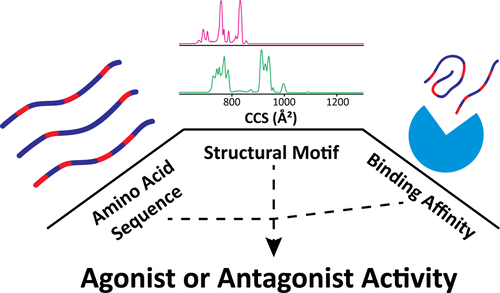Our official English website, www.x-mol.net, welcomes your
feedback! (Note: you will need to create a separate account there.)
Structural Motif Descriptors as a Way To Elucidate the Agonistic or Antagonistic Activity of Growth Hormone–Releasing Hormone Peptide Analogues
ACS Omega ( IF 3.7 ) Pub Date : 2018-07-06 00:00:00 , DOI: 10.1021/acsomega.8b00375 Kevin Jeanne Dit Fouque 1 , Luis M. Salgueiro 2, 3 , Renzhi Cai 2, 3 , Wei Sha 2, 3 , Andrew V. Schally 2, 3 , Francisco Fernandez-Lima 1, 4
ACS Omega ( IF 3.7 ) Pub Date : 2018-07-06 00:00:00 , DOI: 10.1021/acsomega.8b00375 Kevin Jeanne Dit Fouque 1 , Luis M. Salgueiro 2, 3 , Renzhi Cai 2, 3 , Wei Sha 2, 3 , Andrew V. Schally 2, 3 , Francisco Fernandez-Lima 1, 4
Affiliation

|
The synthesis of analogues of hypothalamic neuropeptide growth hormone–releasing hormone (GHRH) is an efficient strategy for designing new therapeutic agents. Several promising synthetic agonist and antagonist analogues of GHRH have been developed based on amino acid mutations of the GHRH (1–29) sequence. Because structural information on the activity of the GHRH agonists or antagonists is limited, there is a need for more effective analytical workflows capable of correlating the peptide sequence with biological activity. In the present work, three GHRH agonists—MR-356, MR-406, and MR-409—and three GHRH antagonists—MIA-602, MIA-606, and MIA-690—were investigated to assess the role of substitutions in the amino acid sequence on structural motifs and receptor binding affinities. The use of high resolution trapped ion mobility spectrometry coupled to mass spectrometry allowed the observation of a large number of peptide-specific mobility bands (or structural motif descriptors) as a function of the amino acid sequence and the starting solution environment. A direct correlation was observed between the amino acid substitutions (i.e., basic residues and d/l-amino acids), the structural motif descriptors, and the biological function (i.e., receptor binding affinities of the GHRH agonists and antagonists). The simplicity, ease, and high throughput of the proposed workflow based on the structural motif descriptors can significantly reduce the cost and time during screening of new synthetic peptide analogues.
中文翻译:

结构性主题描述符,作为阐明生长激素释放激素肽类似物的激动或拮抗活性的一种方法
下丘脑神经肽生长激素释放激素(GHRH)类似物的合成是设计新治疗剂的有效策略。基于GHRH(1-29)序列的氨基酸突变,已经开发了几种有前景的GHRH合成激动剂和拮抗剂类似物。因为关于GHRH激动剂或拮抗剂的活性的结构信息是有限的,所以需要能够使肽序列与生物活性相关的更有效的分析工作流程。在目前的工作中,研究了三种GHRH激动剂(MR-356,MR-406和MR-409)和三种GHRH拮抗剂(MIA-602,MIA-606和MIA-690),以评估取代在促肾上腺皮质激素中的作用。结构基序和受体结合亲和力的氨基酸序列。高分辨率捕获离子迁移谱法与质谱联用的使用,使得可以观察到大量肽特异性迁移率带(或结构基元描述符),它们是氨基酸序列和起始溶液环境的函数。观察到氨基酸取代之间存在直接相关性(即碱性残基和d / l-氨基酸),结构基序描述符和生物学功能(即GHRH激动剂和拮抗剂的受体结合亲和力)。基于结构基序描述符的拟议工作流程的简单性,便捷性和高通量可以在筛选新的合成肽类似物期间显着降低成本和时间。
更新日期:2018-07-06
中文翻译:

结构性主题描述符,作为阐明生长激素释放激素肽类似物的激动或拮抗活性的一种方法
下丘脑神经肽生长激素释放激素(GHRH)类似物的合成是设计新治疗剂的有效策略。基于GHRH(1-29)序列的氨基酸突变,已经开发了几种有前景的GHRH合成激动剂和拮抗剂类似物。因为关于GHRH激动剂或拮抗剂的活性的结构信息是有限的,所以需要能够使肽序列与生物活性相关的更有效的分析工作流程。在目前的工作中,研究了三种GHRH激动剂(MR-356,MR-406和MR-409)和三种GHRH拮抗剂(MIA-602,MIA-606和MIA-690),以评估取代在促肾上腺皮质激素中的作用。结构基序和受体结合亲和力的氨基酸序列。高分辨率捕获离子迁移谱法与质谱联用的使用,使得可以观察到大量肽特异性迁移率带(或结构基元描述符),它们是氨基酸序列和起始溶液环境的函数。观察到氨基酸取代之间存在直接相关性(即碱性残基和d / l-氨基酸),结构基序描述符和生物学功能(即GHRH激动剂和拮抗剂的受体结合亲和力)。基于结构基序描述符的拟议工作流程的简单性,便捷性和高通量可以在筛选新的合成肽类似物期间显着降低成本和时间。





















































 京公网安备 11010802027423号
京公网安备 11010802027423号